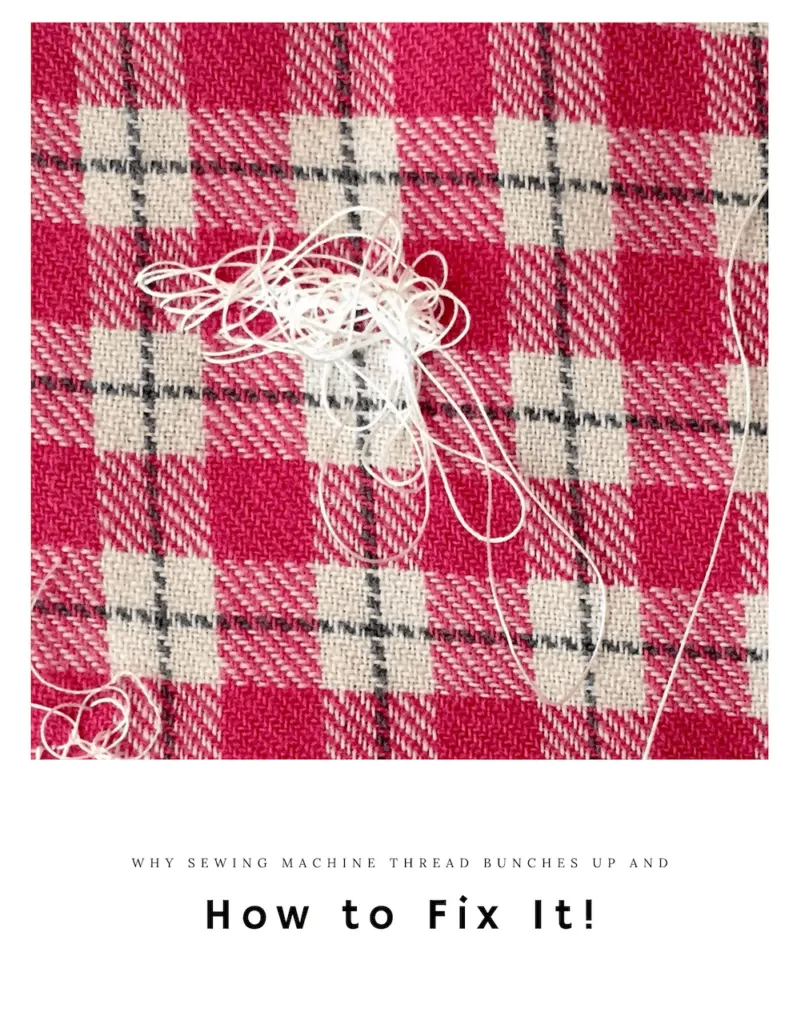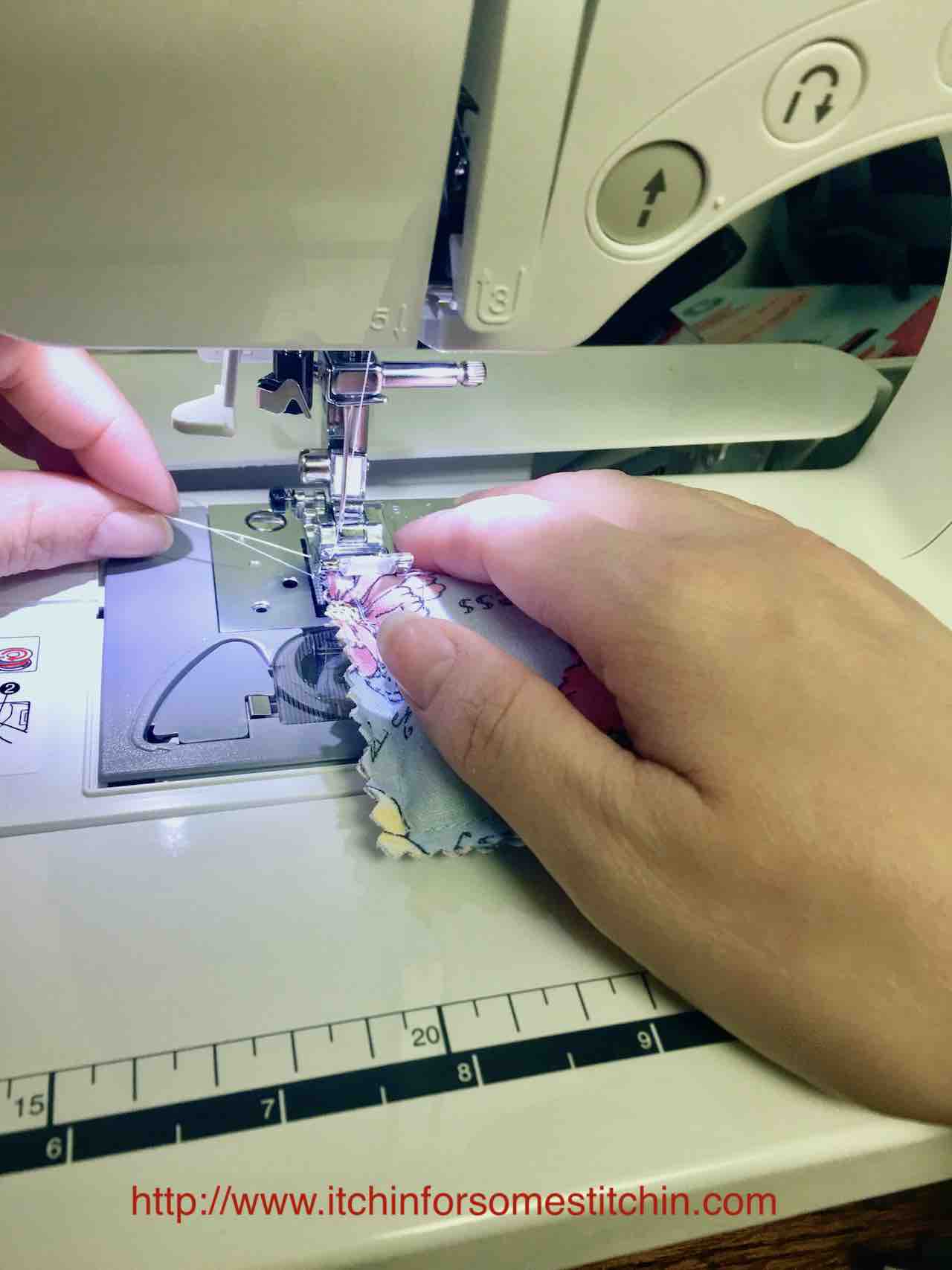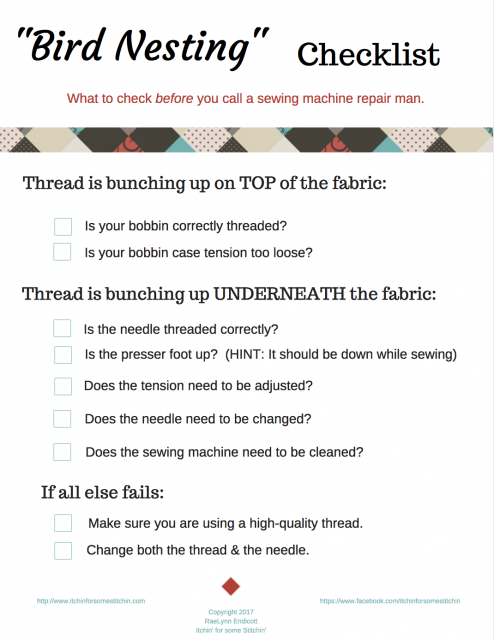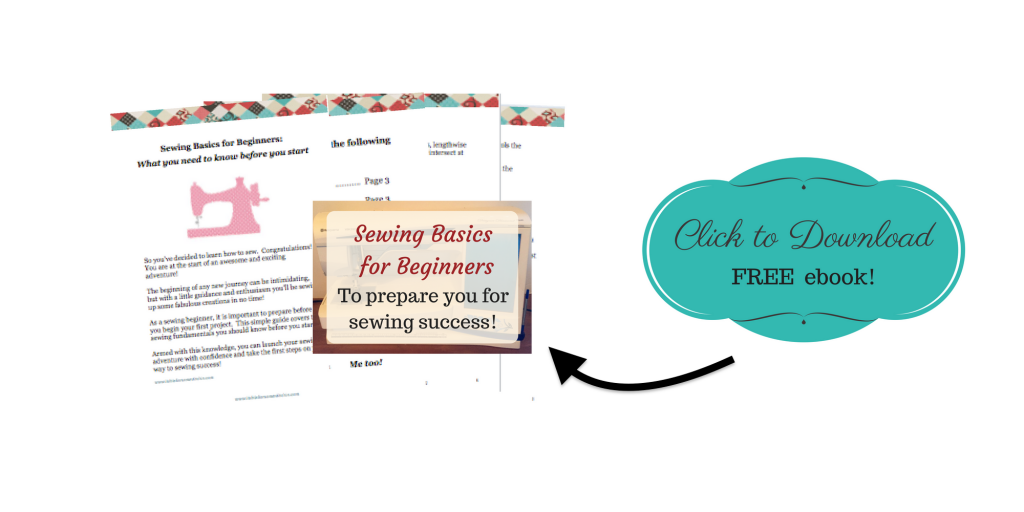
Everything you need to know before calling a sewing machine repairman! This article provides a list of possible reasons for why sewing machine thread bunches up and solutions on how to fix it.
Does this look familiar?
Often called “birdnesting”, this is what it looks like when sewing machine thread bunches up on the top of or on the underside of your fabric.
This is one of the most common problems when using a sewing machine. Not only is this an extremely frustrating issue, it can also put a major stopper in the creative process!
I know because it happened to me.
If this is happening to you, first, don’t panic!
This situation is normally an easy fix and usually doesn’t need a call to your sewing machine repairman.
* This post contains affiliate links. Your support is appreciated! See my full Disclosure Policy for details.
What Causes Sewing Machine Thread to Bunch Up?
Before I go over all the things you can check to fix this annoying problem, let’s first make sure you understand what’s causing the problem.
The short and dirty answer is tension.
Tension seems to be the culprit in the majority of cases. However, this isn’t always the case, so there are other things you can check as well.
Let’s go over tension so you can understand why this can be such a big issue.
Tension is what keeps the top and bottom stitches in perfect balance with one another.
In other words, it’s what keeps the front and back stitches looking the same.
When sewing, the top, and bottom stitches should interlock smoothly and look the same.
However, if the stitches are puckered, the seam is unstable, the thread bunches up, or the stitches are just plain ugly, then there is most likely a problem with incorrect tension on either the top or bottom.
It is important that both the top and bottom tension work together to create proper stitches.
For a better understanding of sewing machine tension, I recommend reading the following articles:
Understanding Thread Tension In Your Sewing Machine
Sewing Lesson 10: How to Fix Tension on Your Sewing Machine
Things to Check When Your Sewing Machine Thread Bunches Up.
When your sewing machine thread bunches up you may also experience thread jamming.
In other words, you may have large tangles and huge clumps of bunched up thread not only on your fabric but inside your sewing machine as well.
This typically occurs in the bobbin area and it can be terrifying to witness!
I have had tangles and bunches of thread in the bobbin area so bad that my machine literally became locked up and I couldn’t even pull the fabric out!
When this happens to you, you will want to cry. Well, at least I did.
You may even panic and schedule an appointment with a repairman.
Fortunately, I left my phone on the hook the first time this happened to me and consulted the great and powerful Google instead.
After lots of research, I was able to successfully fix the issue.
I then wrote down all the tips I learned and decided to share them in this post.
Believe it or not, every time my thread bunches up I consult this checklist. And, if I learn something new, I add it to this post.
So, these are all the things, in my experience, that you can check before making a 911 call to your sewing machine mechanic.
Note: In order to go through this checklist, you should be familiar with your sewing machine and the basic sewing process. If you are new to sewing and/or recently purchased a new sewing machine, make sure you understand all the parts of a sewing machine.
Also please check out the sewing resources page for more information.
» CLICK HERE TO VIEW THE BIRDNESTING CHECKLIST
“Birdnesting” Checklist
The thread is bunching up on TOP of your fabric:
Whenever the sewing machine thread bunches up, or “bird nests”, on the top of your fabric, the problem typically lies with your bobbin.
Here’s what to check:
1. Is your bobbin correctly threaded?
- If the thread has knots, is not smooth, is uneven, or is loose on the bobbin, then it has not been threaded correctly.
- If your machine uses a bobbin case, follow your sewing machine’s instructions to remove the bobbin from the case and re-thread it. Make sure you place it back in the case according to your machine’s instructions.
- Be sure that you have the bobbin thread engaged in the bobbin tension. To test this, hold the bobbin thread with one hand and if the bobbin drops to the floor then you missed the tension spring in the bobbin case.
Check out The Bobbin Tension Trick You May Not Know for more information.
2. Is your bobbin case tension too loose?
- If you have loosened the screw on your bobbin case to allow for thicker threads you may need to re-adjust it for a regular thread.
- After the bobbin case has been correctly threaded, give the bobbin thread a slight tug. The thread should still move freely with some slight resistance.
The thread is bunching up on UNDERNEATH your fabric:
If the thread is bunching up underneath your fabric, don’t assume that the problem is with the bobbin. This is what most people tend to think, however, your needle tension is more likely the true culprit.
Here’s what to check:
1. Is the needle threaded correctly?
- Cut the thread a few inches from the spool and pull it out of the machine through the needle. Re-thread according to the instructions for your machine.
- Always thread the sewing machine with the presser foot up. The tension is engaged when the presser foot is down and the thread will not engage properly in the tension discs.
- Complete engagement is necessary so that the discs can snugly “grasp” the thread.
2. Is the presser foot up?
- Don’t worry. We all do this occasionally. Just put it down and never speak of it to another soul. ?
Note: It has come to my attention that this one might be a bit tricky for some sewing beginners. So, just to be clear, the presser foot should be down during sewing.
3. Does the tension need to be adjusted?
- Even sewing machines that can “sense” your thread and automatically determine proper tension are sometimes wrong.
- Tighten or loosen the tension as necessary.
4. Does your needle need to be changed?
- Make sure you are using the proper needle for the fabric you are using.
- Also, double-check that the needle is not bent. If you pull the fabric instead of guiding it through the feed dogs as you sew then the needle can bend leading to all sorts of sewing machine problems.
5. Does the sewing machine need to be cleaned?
- Frequent cleaning, dusting, and oiling will prevent many stitching problems.
- Make sure to dust underneath the throat plate, in the bobbin case, and along the thread path.
- Proper maintenance takes only minutes and can save you a multitude of headaches.
Still having problems after going through the checklist?
- Then let’s add one more thing to do. It’s time to change your thread. Make sure you are using a high-quality thread. No folks, not all threads are created equal. Stop buying thread from the bargain bins!
- Low-quality threads not only tend to break more often, they also generally have looser fibers. Pieces of broken thread and loose fibers mean more lint in your sewing machine. This can lead to all sorts of problems, including your thread bunching up. It can even cause irreparable damage to your machine. A sewing machine is a substantial investment. You don’t want that investment destroyed because you then decided to use cheap thread.
So, what’s the best sewing machine thread?
Good question. The answer is really one of personal opinion.
- I love Gutermann, but I’ve heard that Mettler, Aurifill, and Robison Anton are also good. When I was a beginning sewer I was not so picky. I grabbed the cheapest thread I could. I even used old thread my grandma had since the 70’s!
- Years of experience, sewing machine problems, and projects that literally fell apart at the seams because I used poor quality thread taught me a valuable lesson. There is no substitute for quality.
- I use Gutermann because it creates less lint, thus, it gunks up your sewing machine less than other threads. It also tangles less than other threads and lasts longer than other threads. Yes, it’s a bit more expensive. I usually try to stock up while it’s on sale. You can find it at it Michaels or on Amazon. The price varies by spool size. (You can also click on the images)
What do you do when all else fails?
- Change your thread and put in a new, sharp sewing machine needle. It’s a winning combination!
I have seriously been at the end of my rope, pulling my hair out in frustration from episodes of birdnesting… tried everything on the list… and failed… only to have it magically fixed by doing these two things at the same time.
This is not an exaggeration.
- Gently hold the end of the thread for the first few stitches when sewing.

This is a tip given to me by multiple readers (check the comments section) and I have tested it myself. So far, I think it definitely helps, and it is something I have added to my normal sewing process.
- If possible, watch your thread uptake lever while sewing.
What Is the Thread Uptake Lever?
The thread uptake lever is the part of the sewing machine that pulls the thread from the spool, feeds it through the machine, and lifts the thread back up out of the fabric after a stitch has been made.
Basically, it’s the part of the sewing machine that goes up and down as you sew.
It’s located directly above the presser foot and is often concealed or obscured by the top plastic shell of the sewing machine.
Sometimes, for whatever reason, even after I have tried absolutely everything and I am sure my tension should be right, the thread will simply fall off the uptake lever.
And then you know what happens? Yep, you guessed it… the thread bunches up!
So, now I have removed the plastic piece on my sewing machine so the thread uptake lever is always in view.
When the thread falls off, I use a pen to gently lift up the thread and place it back on the lever.
Magic!
Take my advice folks and learn from my mistakes. The next time your sewing machine thread bunches up refer to this checklist.
Hopefully, these tips will help you troubleshoot and fix the issue quickly so you can keep the creative juices flowing and keep on sewing!
Be sure to share this post.
Help others solve this frustrating issue!
Until next time… Happy Sewing!

If you are a sewing beginner, perhaps you tackled your sewing project too soon. Don’t despair!
This FREE ebook will help guide you on your way to sewing success!
» CLOSE THE BIRDNESTING CHECKLIST



Susan
Sunday 20th of October 2024
THANK YOU THANK YOU….aftercleaning, changing the bobbin thread, rethreading the machine…..I READ YOUR SIGHT THAT I HAD SAVED…. AND CHANGED THE NEEDLE! TA—-DUH…IM BACK IN BUSINESS SEWING TEDDY BEARS FOR THE NEW BABIES AT OUR HOSPITAL!
Itchin4Stitchin
Sunday 20th of October 2024
Hi Susan,
I am so glad! Thank you so much for taking the time to share and I am so very happy you are back on track - your work is very important to those babies!
Best wishes,
RaeLynn
AFUNFEH EMILIA
Sunday 28th of July 2024
Hi Jane, I have just experienced thread bunch under the fabric now as am trying to see and the experience is frustrating. I almost cried, I barely sew a thing. So I decided to search how to solve this problem on Google and I found your page, it's really been of great help, thank u so much. What I thought was causing the problem was the bobbin and I kept removing checking and arranging but to no avail. But now, I know what to do all thanks to u madam Jane 🙏🙏
Itchin4Stitchin
Thursday 17th of October 2024
Hi Afunfeh,
Thank you so much! I am so glad my little post could help you out.
Best wishes,
RaeLynn
Jane
Tuesday 11th of June 2024
My sister has always blamed my jackrabbit stops and starts for this. I also always assumed a big blob in the bobbin meant the trouble was in the bobbin. Thanks so much! I'd ask where you were 40 years ago, but I suspect you weren't born yet.
Itchin4Stitchin
Saturday 29th of June 2024
Hi Jane,
Believe it or not, I was actually alive 40 years ago... young at the time, but not too young. I'm older than you may think! LOL. Glad the post could help you!
Sincerely,
RaeLynn
Elise
Sunday 5th of May 2024
Been sewing 60 yrs. Whatever I'm sewing, take a doubled over scrap of the fabric as your tension test, play with your loose-tight, etc. Until it looks perfect. Then sew your fabric with that tension top and bottom.
Itchin4Stitchin
Saturday 29th of June 2024
Hi Elise,
Thanks so much for the great tip! I am going to test that out!
Best wishes,
RaeLynn
Robin
Friday 26th of January 2024
This is the most thorough and helpful post I've read about birdnesting! Thanks!
Itchin4Stitchin
Monday 12th of February 2024
Hi Robin,
You are so very welcome! Thank you for stopping by. :)
Sincerely,
RaeLynn